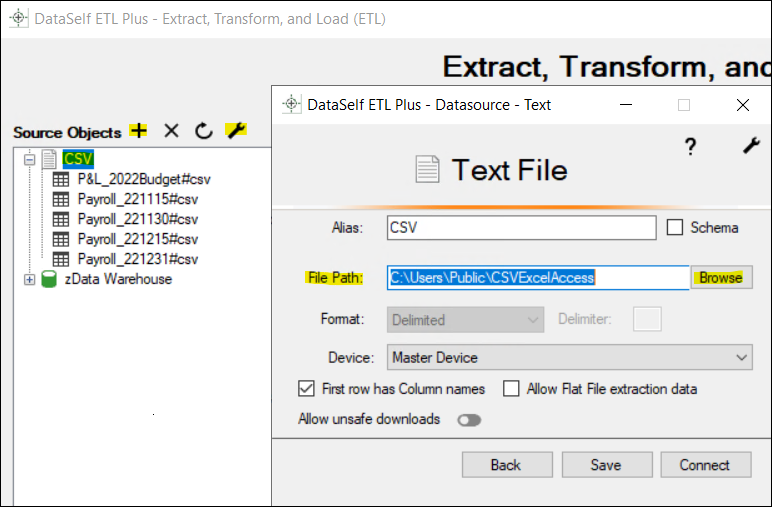ETL+ for CSV and Text Files
The Text File source driver can import .csv format files.
ETL+ Issues Importing from a CSV, Text file
Installation Checklist
Connecting to CSV and Text Files
Currently, these must be comma delimited text files, with the first row with Column headers.
If you haven’t installed ETL+ yet: ETL+ Deployment Instructions.
Loginto ETL+ (help here).Add new .csv files: Select
Add Source> Text on the Source Objects panel.Maintain a text source: Right-click the text source object >
Properties.On the Text File page:
Aliaswill be automatically populated, but you can customize it.File Path:Enter a local file path containing the .csv or .txt files or …
Use Browse or …
Enter an internet URL address.
Device: Leave it as it by default.Allow unsafe downloads: Toggle this on when downloading the CSV from a website that is not SSL-based.Click
Connect.Supported Excel formats: TXT, CSV.

You’ll get back to the ETL page and see tables under the selected text source on the left panel.
Mapping and Loading Tables
To view tables available from a text source on the left panel, right-click the text source →
Refresh.To map a text table to the data warehouse,
double-click its nameon the left panel, or right-click on it →Add Table.You’ll now see the table added/mapped to the center panel.
To preview its data, right-click the table on the center panel →
Preview.To load its data to the data warehouse, right-click the table on the center panel →
Load Now.Click the
Logicon (top right) to view data load results. Log page help here.
Schedule the Data Load
On the ETL main page, click
Job(top right icon on the center panel).The Job page usually comes pre-configured to your source system(s).
Overview this page’s configuration. On the right panel, feel free to uncheck tables and Tableau extracts that don’t apply to your reporting needs.
Run a Job now (optional): click the
Run Job(play icon) on the left panel.To schedule the data load (optional):
Select a
Job→Job Properties(wrench icon) → configure the schedule panel →Save
Click
Close->Close.
Testing
After ETL+ has loaded your text files, this is to check if the data extraction process finished successfully and row count per extracted table matches with your text tables.
Steps
Login to ETL+ (help here).
On the ETL main page, click the top-right
Logicon. Log page help here.Scroll down on the log page and double-check that no table load failed, and the row count matches with the text tables. Following is an example highlighting two tables and their loaded row count.

